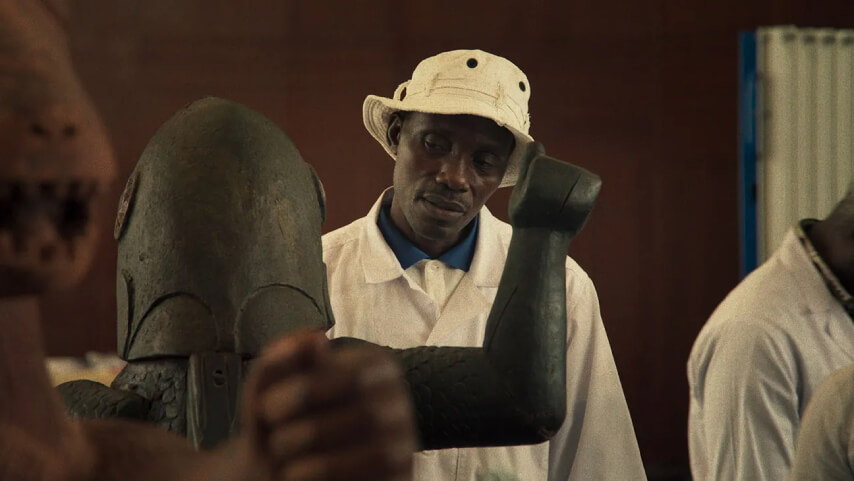A travel documentary doesn’t often focus on the return journey. Its homecomers aren’t often repatriated relics, handed over by those who looted them. But Dahomey, flying from the bowels of a Parisian museum to the lively debate floor at the University of Abomey-Calavi, is all about what happens when you come back. It finds poetic comfort (but no cure) as it considers the practical and poetic machinations of restitution. Filmmaker Mati Diop follows 26 artifacts from the Kingdom of Dahomey (which some may recall from 2022’s The Woman King) as they are returned by France to Benin. Assessing this move from the perspective of the pieces themselves—including an elaborate carved throne, a towering statue of King Ghézo, and metallic markers of death—as well as the recipients of these revenants, Diop takes a brisk yet thoughtful look at whether even antiquities can go home again.
Though Diop and her co-writer Makenzy Orcel grant a living voice to the treasures, manifesting through Orcel’s interspersed and voice-altered narration over a black screen, Dahomey’s structure most often follows the here-to-there trajectory of a process-oriented behind-the-scenes documentary. Amid the COVID pandemic in November 2021, masked art handlers at the Musée du Quai Branly uninstall towering constructions of wood and metal. It’s an engaging peek behind the curtain at the unglamorous world of museum maintenance, a bit like Close To Vermeer with an anticolonial bent. Once they land in Benin, another masked crew carts them to another display hall. The motions are mirrored, the meaning reversed. One is performed in silence, the other done before a cheering crowd. But before half of Dahomey’s brief hour-long runtime fully dives into the nitty-gritty process of taking down, boxing up, shipping off, and welcoming back these relics, it considers where they’ve been.
Diop shoots the Parisian museum’s guts, its empty industrial white hallways, like the uncanny liminal spaces of Chantal Akerman’s Hotel Monterey. These artifacts aren’t just displayed in their glass cases, but held against their will in a kind of curatorial superprison, watched over by black-eyed security cameras. Though Diop anthropomorphizes these items through the self-consciously contemplative voiceover, she elegantly grants them life with just a few camera choices. Filming from the inside of a crate as it’s sealed, shooting from behind the glass when museumgoers ogle the history inside—these offer more soulfulness to the statues than the dreamy spoken interludes.
But the most engaging moments of Dahomey only use its restored objects as a springboard. A group of students in Benin praise, critique, and deconstruct the historic event while the exhibit opens to the public. As affecting sequences quietly play out—young construction workers and painters maintaining the museum pop in to see what all the fuss is about, or Beninese children stare at their previously difficult-to-grasp past—a gripping conversation rages.
Past and present collide both in and outside the museum, questioning the politics motivating this moment, and attempting to come to terms with this baby step forward. (The 26 returned artworks are a drop in the bucket of thousands still held by colonial powers.) Diop finds engaging subjects to represent this mixed reaction, many of whom raise anticolonialist points implied earlier in Dahomey. Sure, returning stolen goods is a positive, but the Beninese press conference celebrating this small victory is still delivered in French. The damage is done, and deep.
And yet, the events of Dahomey never feel like a Band-Aid on a wounded nation. Though its artifacts find themselves in a home they no longer recognize after 130 years overseas, Diop does find magic beneath and behind the smoothing effects of globalization. The vibrant night photography she showcased in Atlantics captures a nation in a neon glow, while a sidetracked conversation into the religion of Vodoun offers a bit of culturally specific comic relief. Though this return’s single gesture is insufficient, it’s as part of a larger whole—another moving part in the accumulation of history—that its meaning sticks.
Director: Mati Diop
Writer: Mati Diop, Malkenzy Orcel
Release Date: October 25, 2024

